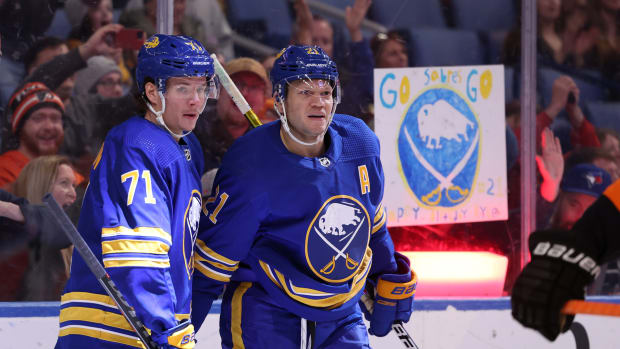The Buffalo Sabres have a lot of cap room to play with, but what will they do with it this summer?
2020-21 Record: 32-29-11
Finish In The Atlantic Division: 5th
Salary Cap Space Available (As Per CapFriendly.com): $34 million
Restricted Free Agents: Victor Olofsson, F; Jacob Bryson, D
Unrestricted Free Agents: Drake Caggiula, F; Cody Eakin, F; John Hayden, F; Vinny Hinostroza, F; Will Butcher, D; Colin Miller, D; Mark Pysyk, D; Malcolm Subban, G; Dustin Tokarski, G
What Buffalo Has: A fan base that has stuck with them, despite 11 years of abject failure, in which they’ve finished as high as fifth in their division just once; a core of promising prospects and young NHLers, including defensemen Owen Power and Rasmus Dahlin, and forwards Dylan Cozens, Jack Quinn, Tage Thompson, Peyton Krebs and numerous others; all sorts of salary cap space; a skilled head coach in Don Granato
What Buffalo Needs: Veteran depth and experience everywhere; ownership willing to commit to being more than a “budget team”; patience to grow their lineup with
What’s Realistic For Buffalo Next Season: The Sabres began and ended the 2021-22 season on positive notes: they went 5-1-1 out of the gate, and went 16-9-3 through the final two months of the year. But it was the in-between part that sunk any hopes of contending for a playoff spot. A pair of six-game losing streaks, and a seven-game losing skid dug a hole that was impossible to climb out from.
It’s true Buffalo showed spunk under head coach Don Granato, and eventually overtook the Detroit Red Wings for fifth place in the Atlantic Division. But don’t let their place in the standings fool you – they had a whopping 19 fewer wins than the Bruins and finished 32 points behind Boston. The gap makes clear how far the Sabres still have to go to be a playoff team, and even with internal growth from within, they simply do not have the depth of talent necessary to take that next step as competitors.
Sabres fans can take some solace in watching dynamic youngsters such as blueliners Owen Power and Rasmus Dahlin, and forwards Peyton Krebs, Dylan Cozens, Jack Quinn and Tage Thompson evolve into Grade-A stars, but there’s not enough “there” there to project them as a night-in, night-out threat to win games. Sabres GM Kevyn Adams just re-signed greybeard goalie Craig Anderson, but with all due respect, the fact he’s 41 years old and posted an .897 save percentage last season and still is seen as their best option in net tells you all you need to know about where Buffalo stands in the overall pecking order.
Team owners Terry and Kim Pegula have kept the Sabres afloat in Buffalo since they purchased the franchise in 2011, but they have had a poor record in management hires, and they certainly aren’t a maximum-payroll organization. They’re up there right now with Arizona and Anaheim in terms of salary cap space, but the fact they only were able to secure a seventh-round draft pick in return for taking on the salary of injured goalie Ben Bishop is a sobering comment on the lack of leverage Adams has on the trade market.
Buffalo will have a couple of veterans that make sense to trade some time in the 2022-23 season: if a team is interested in opening up cap space, they may deal for 2023 unrestricted free agent forward Kyle Okposo and his $6-million cap hit; similarly, if Anderson plays well, he could be an option for a team seeking netminding depth at the trade deadline. But neither of those two will fetch notable assets. The biggest piece they had was former captain Jack Eichel, and he’s long gone. They do have three first-round draft picks in this summer’s draft, but none of the players they take with those picks will be NHL contributors anytime soon.
Is it fair to expect Buffalo will be more consistent next year? Yes, absolutely it is. But even the most hard-core Sabres fan must recognize the long road that remains ahead for this team. Years of mismanagement mean years of an achingly-slow rebuild, and that likely spells another season without playoff hockey in Western New York.



